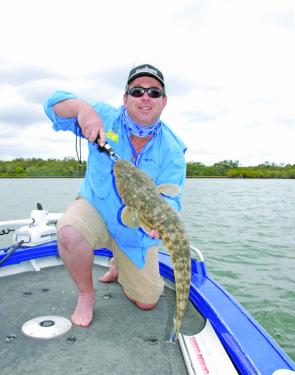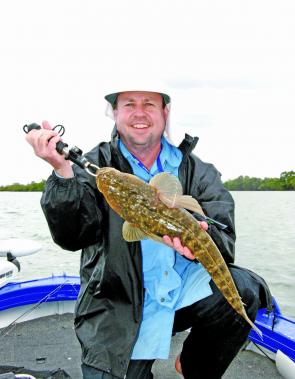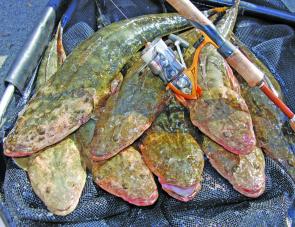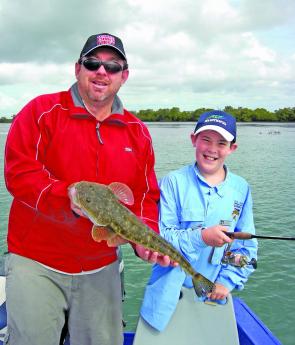Trolling for flathead is making a big comeback and this was highlighted in the 2010 Gold Coast Flathead Classic where the top 2 senior anglers both used trolling as a productive scoring option when conditions were extreme. In fact the winning team relied heavily on trolling too, so there is certainly something to the tactic.
But this article is not about trolling for flathead in deep water, it’s about trolling for flathead in water around 2m (7-8’) deep, often as shallow as 75cm (2-3’). I know that seems a little shallow to most, but the results are in and there is a range of lures made to take advantage of these depths when it comes time to troll.
Flathead are well known to visit shallow water as they ply their ambush trade on unsuspecting baitfish. The real key is understanding the baitfish and their movements. Most baitfish will do everything they can to avoid becoming a flathead’s meal and they therefore look for areas where they can hide or get into water so shallow the flathead cannot follow. This makes shallow water an ideal place for flathead to lie in wait on a making and ebbing tide.
It also pays to remember that flathead camouflage themselves very well and a 70cm flathead hiding in 50cm of water is not unusual. And that fish is so well camouflaged that even very observant eyes cannot see it, so the baitfish really do have Buckley’s Chance of noticing the flatty until it’s too late.
So don’t be afraid of the shallows, you should embrace them as an important fishing destination for flathead of all sizes.
How do you go about targeting these shallow water fish? Surely it can’t be as easy as just chucking a lure out the back and trolling around, can it? And what lures are on the market that will work?
To answer these questions and get a bit more insight into shallow water trolling for flathead I have enlisted the help of some successful flathead trollers and asked them a range of questions – well actually I pried as much info out of them as I could – so that we can all be better prepared next flathead season.
Shayne works with me at Fishing Monthly and is one of the best flathead anglers I have fished with. And yes it kills me to admit that in any place he will see it. His results in the 2010 Flathead Classic speak volumes of his ability to firstly find fish, and then make the most of the situation and catch them. He has been trolling up flathead for over 15 years and his thoughts are clear on what’s needed. What follows are Shayne’s words.
“Trolling for flathead has always been about shallow water for me. It was where I’d caught most of my flathead fishing bait and continues to be the place I catch most of my flathead when cast and retrieve fishing soft plastics and hard bodies.
“My flathead trolling tips are pretty simple. First off I like to fish in water that is around 5 feet (1.5m) deep. Trolling this water depth means that you will be presenting your lure to fish from about 2 feet through to about 8 feet as you zig zag across the flats and channel edges trying to keep the boat in 5 feet. And this is important as I don’t think your lure needs to be in exactly 5 feet. It’s better to have it wandering a bit deeper, then a bit shallower.
“I’ll also look for weed edges as the weed provides cover not only for the baitfish, but for the flathead. The number of flathead you’ll find with their noses and eyes on the edge of a weed bed is staggering.
“As far as the trolling mechanics go, always try to go as slow as possible and make sure your lures are hitting the bottom. It’s not that flathead are slow, but a slow troll gives the fish a little more time to size up the offering. And the lure hitting the bottom sends up those enticing puffs of sand and silt that further attract the flathead.
“With your set up, always use an outfit that allows you to feel how the lure is working. That means a relatively light tip. This way you can easily feel what the lure is doing, what it’s running over and whether or not it’s fouled with weed. The butt section needs to have a bit of strength about it too just in case you need it on an oversized fish.
“I also fish a light drag when trolling, just enough to set the hook. Flathead will not generally snag you up so allowing them to run freely while you organise the boat (stop it, clear other rods and get it facing the right direction) with the fish away from danger and in the clear,” finished Shayne.
Shayne McKee’s Top 5 lures
1. Lively Lure Micro Mullet
2. Halco Scorpion 55 shallow
3. Bomber B14A
4. Rebel Wee Crawdad
5. Baby Merlin
Ben Job forms part of the very formidable flathead fishing team that includes his father and Ross McCubbin. In 2009 Ben landed a cracking 90cm flathead trolling in the last half an hour of the Flathead Classic to take out the biggest flathead award for that year. His knowledge about flathead trolling is massive and worth noting.
“Trolling for flathead is becoming a bit of a ‘forgotten art’, but what people don’t realise is there is far more to trolling then meets the eye. The idea of putting out a few lures and driving around until a fish, in this case flathead, jumps on, probably comes to mind for most when trolling is considered.
“For me there is a real knack to flathead trolling; working a chosen area thoroughly and lure selection can be far more in depth then you may think.
“Start by trying to notice the obvious things: a bit of a drop off and some scattered weed or broken bottom, along with some clean water and you have found yourself a great place to start. I don’t particularly like working spots that are too shallow, you will catch flathead trolling in water as shallow as your boat can stay floating but I like targeting water from 6-8’ deep.
“I’m a big fan of using quite small lures when trolling for lizards. Most times my lures are not much bigger than a jelly bean. I believe a small lure will always tempt a flathead even if he is not hungry. The old saying of elephants will eat peanuts, definitely applies here! My best flathead fell to a tiny lure on the troll and along with that I have caught plenty of really big fish trolling small lures.
“Trolling is an extremely effective way to target flathead of all sizes, and I find that you will often catch fish trolling when they will bite on nothing else, so if you find yourself out of luck on the cast or you’re just sick of chucking rubber give trolling a go,” finished Ben.
Ben Job’s Top 5 lures
1. Lively Lure Micro Mullet
2. Ecogear SX60
3. Lively Lure Mad Mullet 2.5” deep
4. Pig Lure Piglet
5. Tilsan Bass
Brad is a rod building genius found on the Gold Coast and it’s a rare day not to see him being successful when chasing flathead. He fishes the Flathead Classics with his son Ben and regular partner Ross McCubbin and freely admits that trolling is something you must get right to be successful when flathead fishing.
Brad says “One rod fished well, is better than two fished badly!
“This has always been a rule I have stuck by when trolling for flatties. So often I see boats trolling with little V’s trailing along behind the boat, especially towards the end of the day. Trolling should never be boring as a keen angler must stay in touch with their lure.
“With the use of braided lines and graphite rods it is now possible to feel every tap from a fish or your lure action dampened from a small piece of weed. The moment your lure is impeded by weed, it is time to clear it. Sometimes this can be achieved by sharply jigging your rod forward and other times it is a matter of pulling in your lure and manually clearing the weed.
“Trolling must never be an aimless journey of driving around the estuary. It is a skilful art of placing your lure in the most likely location at all times. Read the water and try to imagine where an ambush predator like a flathead would be positioned to give itself the best opportunity of finding a feed. Look for signs like baitfish in the area, good water quality and work a location thoroughly.
“Sounders are common place now in most boats and these little gems are a tool that should be used to maintain a trolling pattern that keeps your lure in the strike zone at all times. You must know what depth your lure is running at and all anglers in the boat must run lures that will ensure they are always in prime locations.
“Before you go trolling for flatties, work out a game plan in your head and aim to be in your prime locations at the right stage of the tide. However, be flexible and observant as sometimes a new area will appear on a certain stage of the tide that you had not previously found,” finished Brad.
Brad Job’s Top 5 lures
1. Lively Lure Micro Mullet
2. Pig Lures Piglet
3. Tilsan Bass
4. Eddy Wasp
5. Brad Smith Lures
Hopefully the above has given you some inspiration to go out and re-discover trolling for flathead. It’s not overly complicated and in foul weather where casting lures is just too hard, trolling can mean the difference between bent rods and empty bags.
Thanks to the guys who helped with their information, I know I’ll be out there using some of it in the next few months to catch myself a flatty or three for dinner – just remember the bag and size limits, or better yet, limit your take to what you can eat in one meal sop they’ll be there next trip.
Facts
Lively Lures Micro Mullet
All of the anglers I talked to regarding this feature praised one lure in particular, the Lively Lure Micro Mullet. It got me thinking about why this lure was so highly regarded so to answer that I thought I’d get the drum from the horses mouth.
Alan Dolan designed and developed the Micro Mullet to meet particular needs. As Alan told me “The Micro basically came about from a conversation with the Gold Coast’s David Green.
“Greeny wanted a small lure to troll behind his kayak that did not dive too deep.
“So I designed a smaller bodied Mad Mullet with a shallow diving bib that Greeny tried out.
“His feedback suggested it was diving too shallow so I fiddled with the design and came up with the Micro Mullet in its current form.
“It was an immediate hit with Greeny and his mates and soon entered into the Lively Lures’ range,” said Alan.
Design history aside, what I found really interesting was Alan’s thoughts on why the Micro Mullet was such a good flathead trolling lure.
“There are a few things I like to incorporate into my lures, the primary one being action. I try to make my lures work hard at slow speeds. By that I mean their cadence [the speed of the sway or their beat] should be high. This high frequency of movement is a big attractant to flathead and other species,” Alan said.
“The other design feature I wanted to achieve was to get the lure to flick around and puff up sand and mud just like a feeding whiting. I think the Micro does this beautifully.
“When being trolled, or cast and retrieved for that matter, the Micro tends to hit the bottom, almost pause for a moment, then flick away from the bottom quickly pushing up a puff of sand or mud. The quick flick away from the bottom, the puff of sand and the vibration all combine as a deadly attractant to fish,” said Alan.
Alan also commented that the Micro is easily fished in water depths from 2 feet down to about 10 feet and all of our anglers interviewed really liked the way the Micro Mullet tended to clean itself of annoying weed. As Shayne McKee said “A quick rip of the rod tip clears the lure of weed allowing you to keep fishing”. Alan seems to think that this weed clearing is an added advantage of the fast cadence and hard swimming action of the lure. Just another favourable point for this great little lure.
Lively Lures Micro Mullets come in a range of colours. All catch fish, but this selection is a good representation of our favourites.

Shayne McKee with a great flatty trolled up in the 2010 Flathead Classic. This fish went a touch over 70cm and was landed on a Lively Lures Micro Mullet in green and black in only 3 feet of water.

Shane Juttner with a typical wet and fowl weather trolled up flathead. This fish smashed a Willow Minnow fished in 4 feet of water on a run out tide.

Good bags of tasty flatties can be scored if you troll well in the shallow waters of the Gold Coast and anywhere flatties lurk for that matter.

Even I can catch a flatty or two on the troll. Fish this size are common on smaller lures fished in shallow water.

Shayne’s son Bart is a keen flatty fisher. This one came just on low tide and fell to the omni-present Lively Lures Micro Mullet, this time in gold.

(with fact Box)

Ben Job with his 90cm Flathead Classic special. This is the ultimate reward for concentrating on trolling.




